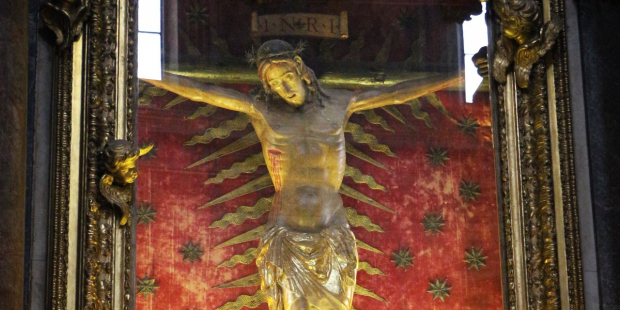Miraculous crucifix of the plague of 1522 transferred to San Pietro for the blessing of Pope 'Urbi et Orbi'

Pope Francis prayed before this image when he left the Vatican on a mini pilgrimage to implore the end of the pandemic
On the famous Via del Corso, known for being one of the busiest shopping streets in Rome, there is the church of San Marcello, which preserves a revered and miraculous image of Christ crucified.
That image has now been moved to St. Peter's so that it will be present for the historic Urbi et Orbi blessing that Francis will give on March 27.
Why this crucifix?
The church of San Marcello was built for the first time in the XNUMXth century, sponsored by Pope Marcello I, who was subsequently persecuted by the Roman emperor Maxentius and sentenced to do the heaviest work in the stables of the catabolo (the central state post office) until he died of fatigue. His remains are preserved in the church, which he sponsored and which took its name from his holy name.
In the night between 22 and 23 May 1519, the church was devastated by a terrible fire that completely reduced it to ash. At dawn, the desolate came to see the tragic scene of still smoking debris. There they found the crucifix suspended above the main altar, providentially intact, illuminated by the oil lamp which, although deformed by the flames, still burned at the foot of the image.
They immediately shouted that it was a miracle, and the most devoted members of the faithful began to gather every Friday to pray and light the lamps at the foot of the wooden image. Thus was born the "Archconfraternity of the Holy Crucifix in Urbe", which still exists today.
However, this was not the only miracle that happened in relation to the crucifix. The next dates back to three years later, in 1522, when a terrible plague struck the city of Rome so badly that it was feared that the city would simply cease to exist.
Desperate, the friars of the Servi di Maria decided to take the crucifix in a penitential procession from the church of San Marcello, finally arriving at the Basilica of San Pietro. The authorities, fearing the risk of contagion, tried to prevent the religious procession, but people in their collective despair ignored the ban. The image of Our Lord was brought to the streets of the city by popular acclamation.
This procession lasted several days, the time needed to be transported throughout the area of Rome. When the crucifix returned to its place, the plague stopped completely and Rome was saved from being exterminated.
Since 1650, the miraculous crucifix has been brought to St. Peter's Basilica during every holy year.
Place of prayer
During the Lent of the Great Jubilee of the year 2000, the miraculous crucifix was exposed on the altar of the confession of San Pietro. It was in front of this image that St. John Paul II celebrated the "Day of Forgiveness"
Pope Francis also prayed before the Holy Crucifix on March 15, 2020, calling for an end to the scourge of the coronavirus that has brought so many lives around the world.